Salby M.L. Fundamentals of Atmospheric Physics
Подождите немного. Документ загружается.

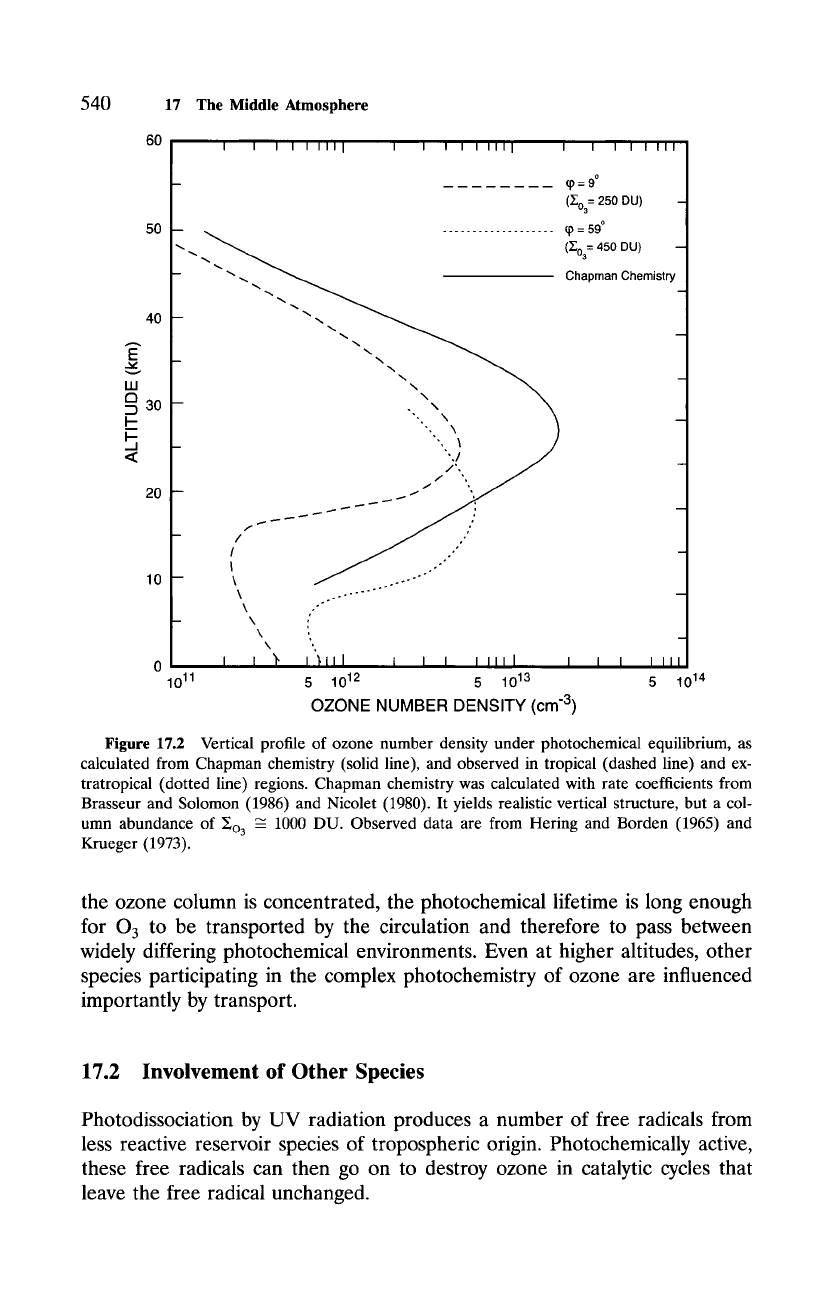
540
17 The Middle Atmosphere
60
50
40
E
v
iii
D
30
t-
i-
_1
<
20
10
1011
I I I I I III I I I I I I Illi I I I I I III
- ~p= 90
(Eo3= 250 DU) -
.................... (p=59 ~
..
[ oo"
_
-- \
\ o~ ..... .o _
\ ,o~
- \
o
\
\ ,
I I 'F I lill I I I i ill I I I I
5 1012 5 1013
OZONE NUMBER DENSITY (cm 3)
(•03= 450 DU)
Chapman
Chemistry
I III
5 10
TM
Figure
17.2 Vertical profile of ozone number density under photochemical equilibrium, as
calculated from Chapman chemistry (solid line), and observed in tropical (dashed line) and ex-
tratropical (dotted line) regions. Chapman chemistry was calculated with rate coefficients from
Brasseur and Solomon (1986) and Nicolet (1980). It yields realistic vertical structure, but a col-
umn abundance of Eo3 ~ 1000 DU. Observed data are from Hering and Borden (1965) and
Krueger (1973).
the ozone column is concentrated, the photochemical lifetime is long enough
for 03 to be transported by the circulation and therefore to pass between
widely differing photochemical environments. Even at higher altitudes, other
species participating in the complex photochemistry of ozone are influenced
importantly by transport.
17.2 Involvement of Other Species
Photodissociation by UV radiation produces a number of free radicals from
less reactive reservoir species of tropospheric origin. Photochemically active,
these free radicals can then go on to destroy ozone in catalytic cycles that
leave the free radical unchanged.
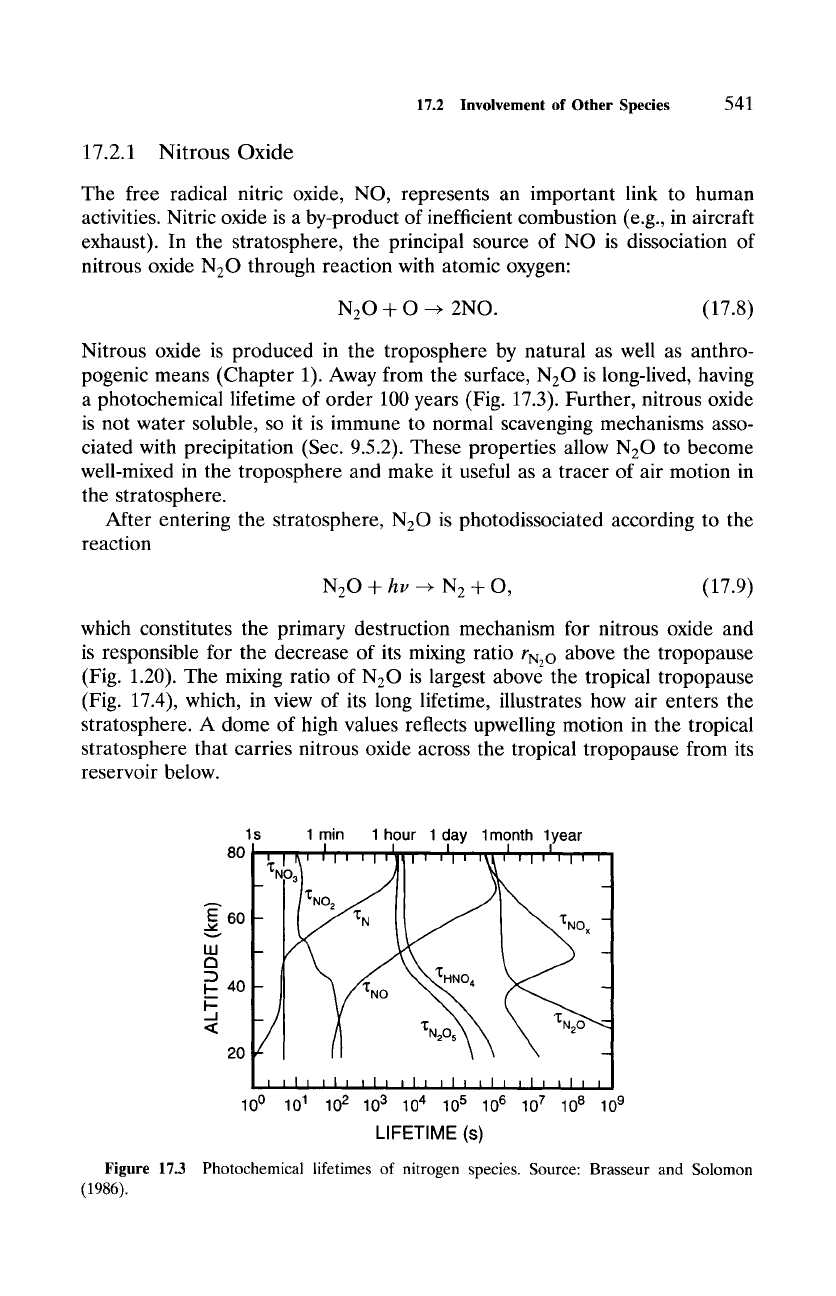
17.2 Involvement of
Other Species
541
17.2.1 Nitrous Oxide
The free radical nitric oxide, NO, represents an important link to human
activities. Nitric oxide is a by-product of inefficient combustion (e.g., in aircraft
exhaust). In the stratosphere, the principal source of NO is dissociation of
nitrous oxide
N20
through reaction with atomic oxygen:
N20 + O --+
2NO. (17.8)
Nitrous oxide is produced in the troposphere by natural as well as anthro-
pogenic means (Chapter 1). Away from the surface,
N20
is long-lived, having
a photochemical lifetime of order 100 years (Fig. 17.3). Further, nitrous oxide
is not water soluble, so it is immune to normal scavenging mechanisms asso-
ciated with precipitation (Sec. 9.5.2). These properties allow
N20 to
become
well-mixed in the troposphere and make it useful as a tracer of air motion in
the stratosphere.
After entering the stratosphere,
N20 is
photodissociated according to the
reaction
N20 +
hv
--~ N 2 + O,
(17.9)
which constitutes the primary destruction mechanism for nitrous oxide and
is responsible for the decrease of its mixing ratio rN2 o above the tropopause
(Fig. 1.20). The mixing ratio of N20 is largest above the tropical tropopause
(Fig. 17.4), which, in view of its long lifetime, illustrates how air enters the
stratosphere. A dome of high values reflects upwelling motion in the tropical
stratosphere that carries nitrous oxide across the tropical tropopause from its
reservoir below.
Figure 17.3
(1986).
ls
80 ,
E 6O
LU
a
_ 4O
_J
<
20
100
1 min 1 hour 1 day 1month 1year
~' /"
''"11"
'"' '\~"'"i'"
,
I I I I I I i
Ill Ill ill 111 III ill
I
101 102 103 104 105 106 107 108 109
LIFETIME (s)
Photochemical lifetimes of nitrogen species. Source: Brasseur and Solomon
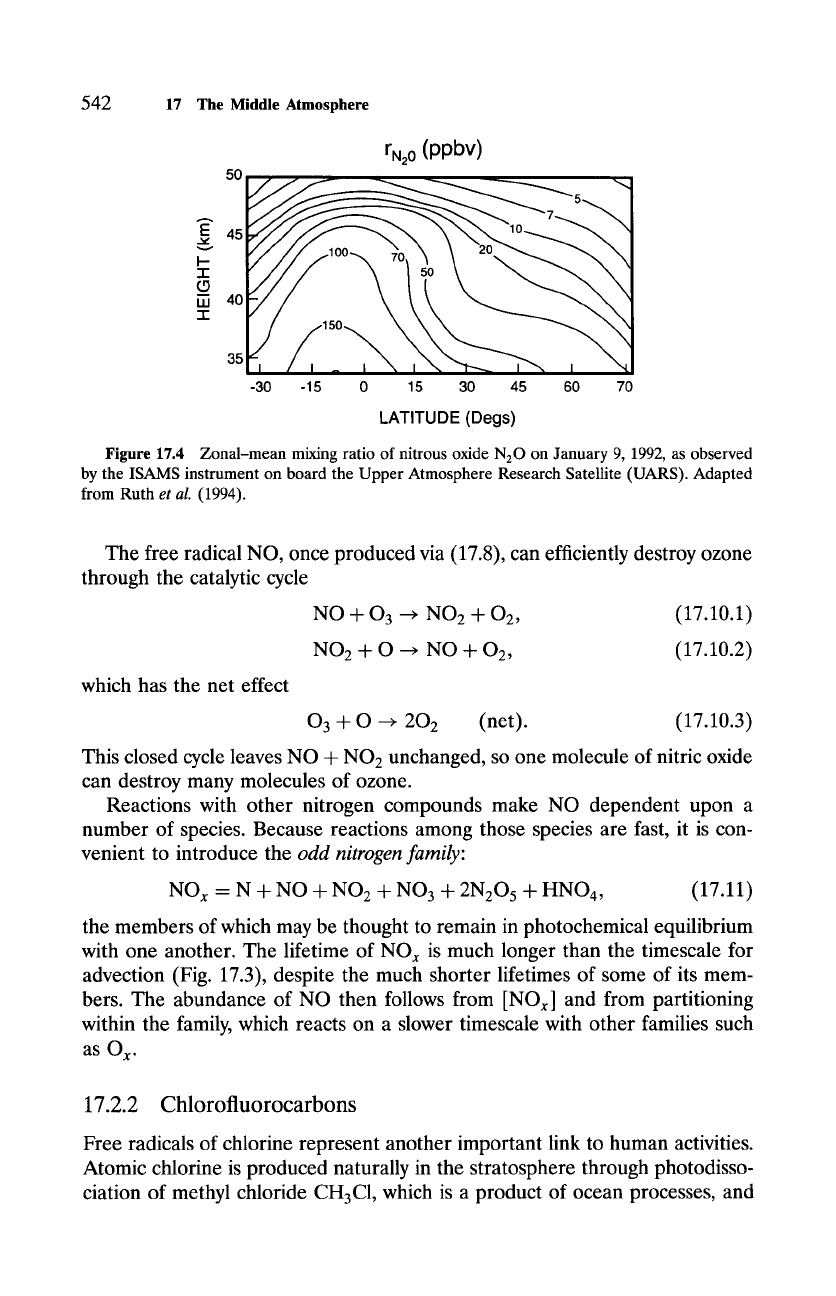
542
17 The Middle Atmosphere
rN2 o (ppbv)
50
4s
100 70
5O
40
"T" 150
35
-30 -15 0 15 30 45 60 70
LATITUDE (Degs)
Figure 17.4 Zonal-mean mixing ratio of nitrous oxide N20 on January 9, 1992, as observed
by the ISAMS instrument on board the Upper Atmosphere Research Satellite (UARS). Adapted
from Ruth
et al.
(1994).
The free radical NO, once produced via (17.8), can efficiently destroy ozone
through the catalytic cycle
NO +
03 ~
NO 2 -k-
02,
(17.10.1)
NO 2 -k- O --+
NO +
02,
(17.10.2)
which has the net effect
03 -1- 0 ~ 202
(net). (17.10.3)
This closed cycle leaves NO + NO2 unchanged, so one molecule of nitric oxide
can destroy many molecules of ozone.
Reactions with other nitrogen compounds make NO dependent upon a
number of species. Because reactions among those species are fast, it is con-
venient to introduce the
odd nitrogen family:
NOx = N + NO + NO2 +
NO 3
+ 2N205 +
HNO4,
(17.11)
the members of which may be thought to remain in photochemical equilibrium
with one another. The lifetime of NOx is much longer than the timescale for
advection (Fig. 17.3), despite the much shorter lifetimes of some of its mem-
bers. The abundance of NO then follows from [NOx] and from partitioning
within the family, which reacts on a slower timescale with other families such
as Ox.
17.2.2 Chlorofluorocarbons
Free radicals of chlorine represent another important link to human activities.
Atomic chlorine is produced naturally in the stratosphere through photodisso-
ciation of methyl chloride CH3C1, which is a product of ocean processes, and
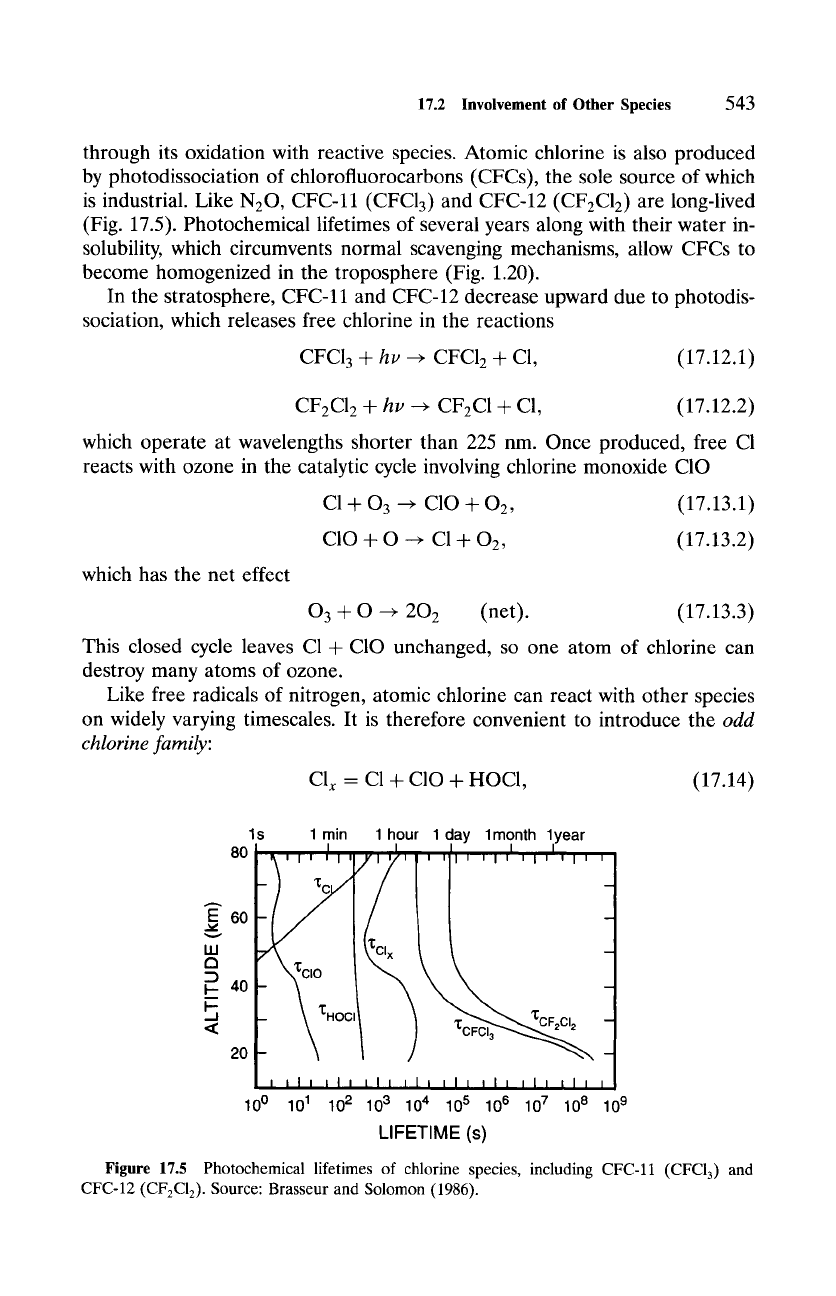
17.2 Involvement of Other Species 543
through its oxidation with reactive species. Atomic chlorine is also produced
by photodissociation of chlorofluorocarbons (CFCs), the sole source of which
is industrial. Like N20, CFC-11 (CFC13) and CFC-12 (CF2C12) are long-lived
(Fig. 17.5). Photochemical lifetimes of several years along with their water in-
solubility, which circumvents normal scavenging mechanisms, allow CFCs to
become homogenized in the troposphere (Fig. 1.20).
In the stratosphere, CFC-11 and CFC-12 decrease upward due to photodis-
sociation, which releases free chlorine in the reactions
CFC13 + hv -+ CFC12 + C1,
(17.12.1)
CF2C12 + hv -+ CF2C1 + C1, (17.12.2)
which operate at wavelengths shorter than 225 nm. Once produced, free CI
reacts with ozone in the catalytic cycle involving chlorine monoxide CIO
C1 + 03 ~ CIO + 02, (17.13.1)
C10 + O --+ CI + 02, (17.13.2)
which has the net effect
0 3 + O --+ 20 2 (net). (17.13.3)
This closed cycle leaves C1 + C10 unchanged, so one atom of chlorine can
destroy many atoms of ozone.
Like free radicals of nitrogen, atomic chlorine can react with other species
on widely varying timescales. It is therefore convenient to introduce the odd
chlorine family:
C1 x = C1 + C10 + HOC1, (17.14)
1 Tin
g
60
40
<
20
Is
80
1
I
1 hour 1 day 1month 1year
i I I
i I I I I I I I I I I I I
I I I I I I I I ili I I i I I I I I I i I I ili I [
100 101 102 103 104 105 106 107 108 109
LIFETIME (s)
Figure
17.5 Photochemical lifetimes of chlorine species, including CFC-11
(CFC13)
and
CFC-12 (CF2C12). Source: Brasseur and Solomon (1986).
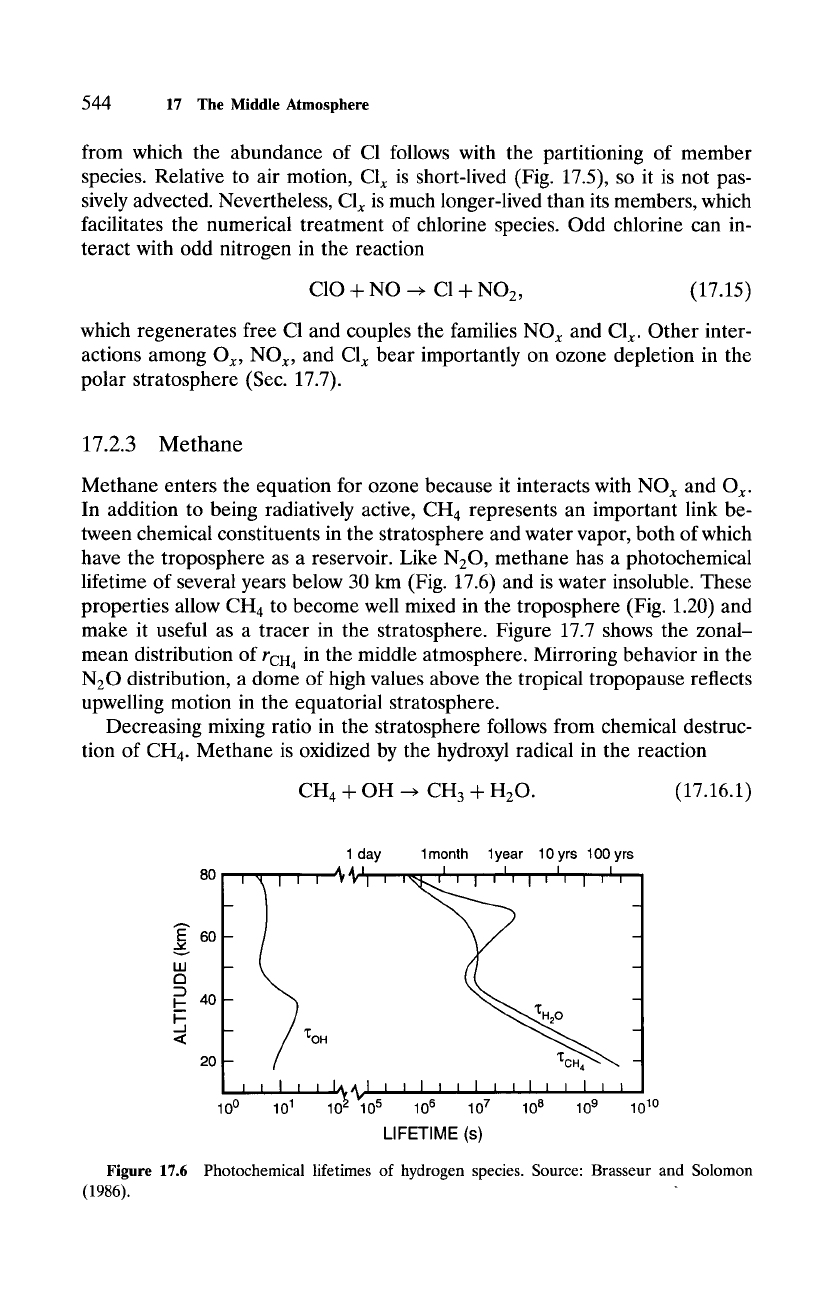
544
17 The Middle Atmosphere
from which the abundance of C1 follows with the partitioning of member
species. Relative to air motion, CII is short-lived (Fig. 17.5), so it is not pas-
sively advected. Nevertheless, Clx is much longer-lived than its members, which
facilitates the numerical treatment of chlorine species. Odd chlorine can in-
teract with odd nitrogen in the reaction
C10 + NO ~ C1 +
NO2,
(17.15)
which regenerates free C1 and couples the families NOx and Clx. Other inter-
actions among Ox, NOx, and C1 x bear importantly on ozone depletion in the
polar stratosphere (Sec. 17.7).
17.2.3 Methane
Methane enters the equation for ozone because it interacts with NOx and Ox.
In addition to being radiatively active,
CH 4
represents an important link be-
tween chemical constituents in the stratosphere and water vapor, both of which
have the troposphere as a reservoir. Like
N20 ,
methane has a photochemical
lifetime of several years below 30 km (Fig. 17.6) and is water insoluble. These
properties allow
CH 4 to
become well mixed in the troposphere (Fig. 1.20) and
make it useful as a tracer in the stratosphere. Figure 17.7 shows the zonal-
mean distribution of rCH 4 in the middle atmosphere. Mirroring behavior in the
N20
distribution, a dome of high values above the tropical tropopause reflects
upwelling motion in the equatorial stratosphere.
Decreasing mixing ratio in the stratosphere follows from chemical destruc-
tion of
CH 4.
Methane is oxidized by the hydroxyl radical in the reaction
CH 4 --I-OH ~ CH 3 --I- H20.
(17.16.1)
1day 1month 1year lOyrs lOOyrs
80 i I ~ "
g 60
2 4o
I~OH
20 I~CH 4
-
I ' 104~110 I I [ I I [ ' ' I ' ' I ' '
10 0 101 1 5 10 6 10 7 10 8 10 9 1010
LIFETIME (s)
Figure
17.6 Photochemical lifetimes of hydrogen species. Source: Brasseur and Solomon
(1986).
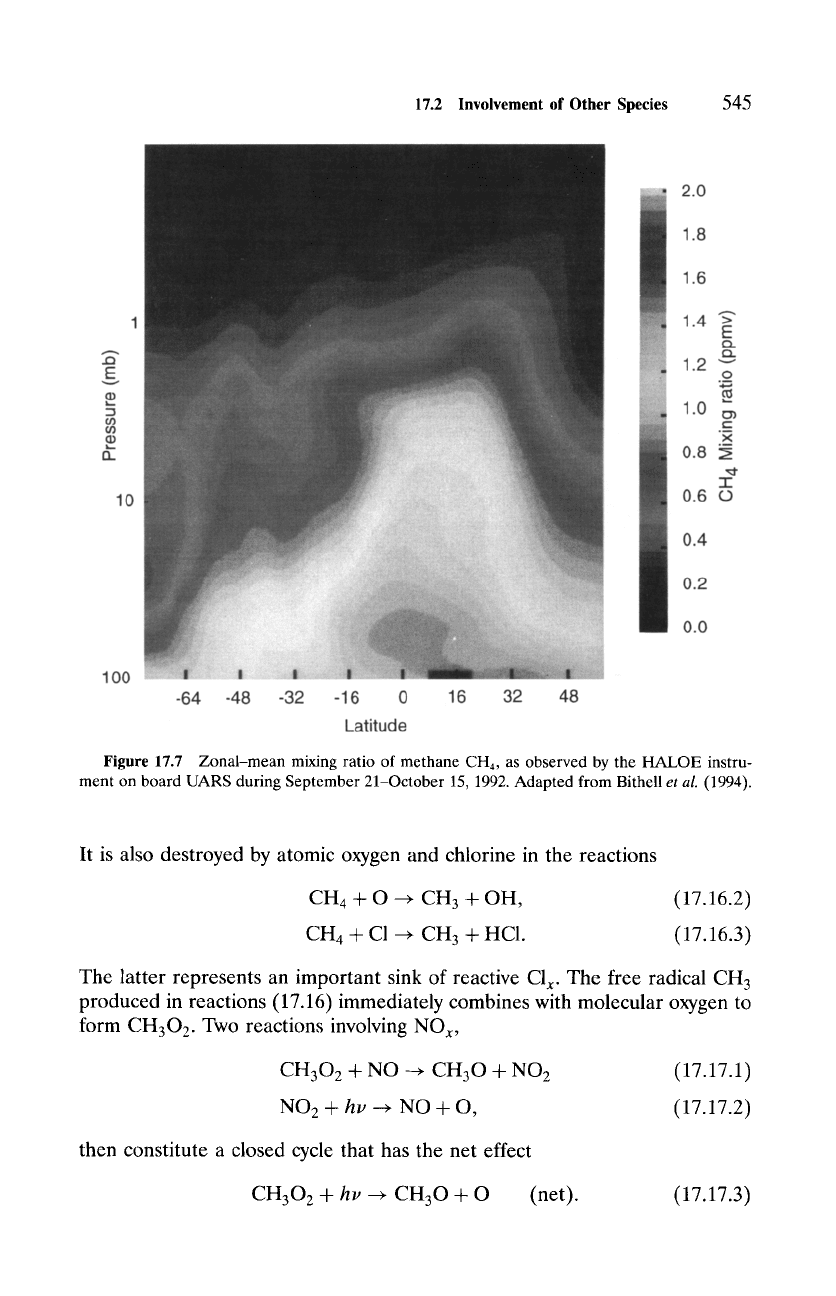
17.2 Involvement of Other Species
545
..Q
E
v
Q)
(/)
Q)
n
10
100
ii!!iiiiiiiiiii!ii!il
!ii!iii!iiiiiiii!!i!
!~i~!i!ii!iiiiiii!~
2.0
1.8
1.6
>
1.4 E
Q.
1.2
.o
1.0
.=_
X
o.a
I
0.6
o
0.4
0.2
0.0
-64 -48 -32
-16
0 16 32 48
Latitude
Figure 17.7 Zonal-mean mixing ratio of methane CH4, as observed by the HALOE instru-
ment on board UARS during September 21-October 15, 1992. Adapted from Bithell
et al.
(1994).
It is also destroyed by atomic oxygen and chlorine in the reactions
CH 4 + O ~ CH 3 + OH,
CH 4 + C1 --+ CH 3 + HC1.
(17.16.2)
(17.16.3)
The latter represents an important sink of reactive Cl x. The free radical CH 3
produced in reactions (17.16) immediately combines with molecular oxygen to
form CH302. Two reactions involving NO~,
CH302 + NO --~ CH30 + NO 2
NO 2 +
hv --+
NO + O,
(17.17.1)
(17.17.2)
then constitute a closed cycle that has the net effect
CH302 +
hv ~
CH30 + O
(net).
(17.17.3)
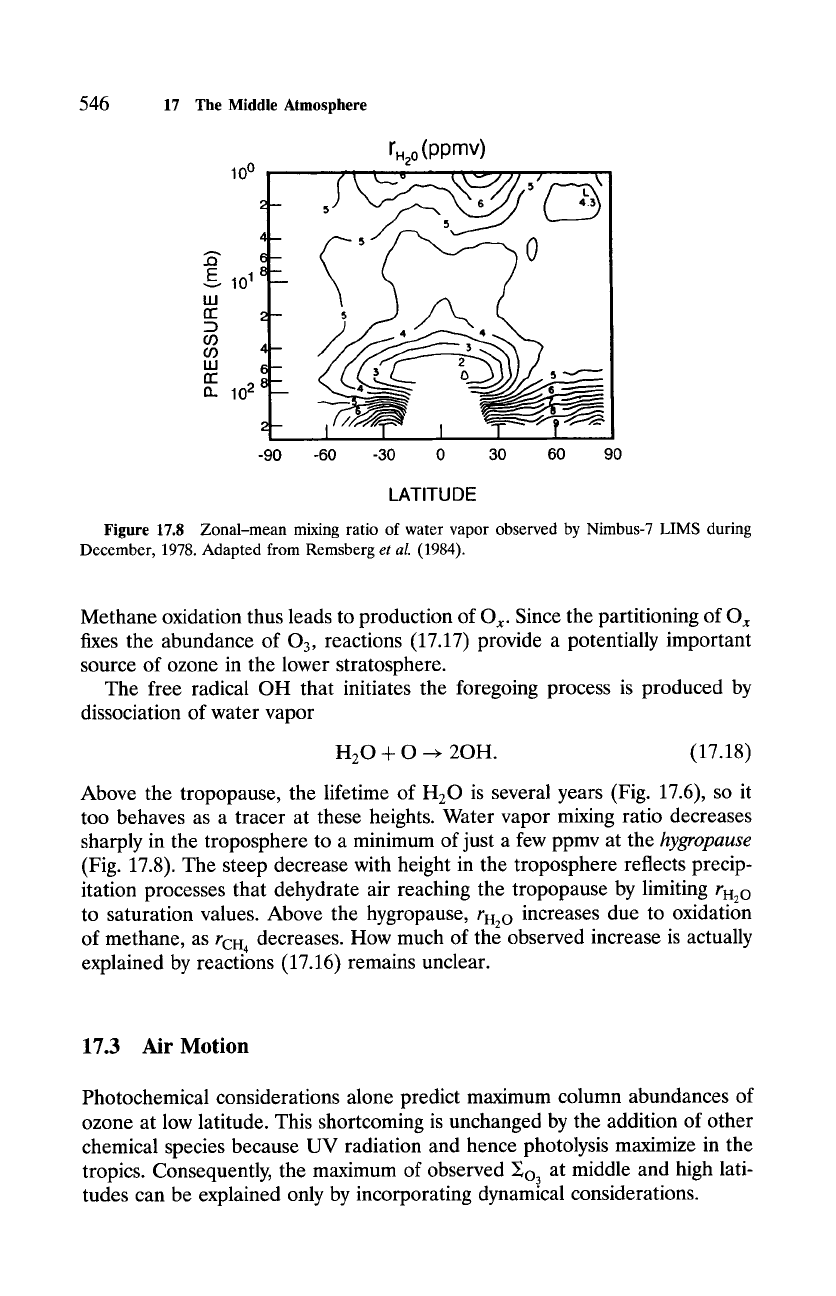
546
17
The Middle Atmosphere
10 0
101
LU
n"
ID
O9
Or)
ILl
n'-
12.
102
-90
r. o
(ppmv)
-60 -30 0 30 60 90
LATITUDE
Figure
17.8 Zonal-mean mixing ratio of water vapor observed by Nimbus-7 LIMS during
December, 1978. Adapted from Remsberg
et al.
(1984).
Methane oxidation thus leads to production of Ox. Since the partitioning of Ox
fixes the abundance of 03, reactions (17.17) provide a potentially important
source of ozone in the lower stratosphere.
The free radical OH that initiates the foregoing process is produced by
dissociation of water vapor
H20 + O --+ 2OH.
(17.18)
Above the tropopause, the lifetime of
H20
is several years (Fig. 17.6), so it
too behaves as a tracer at these heights. Water vapor mixing ratio decreases
sharply in the troposphere to a minimum of just a few ppmv at the
hygropause
(Fig. 17.8). The steep decrease with height in the troposphere reflects precip-
itation processes that dehydrate air reaching the tropopause by limiting rH2 o
to saturation values. Above the hygropause, rH~O increases due to oxidation
of methane, as rCH 4 decreases. How much of the observed increase is actually
explained by reactions (17.16) remains unclear.
17.3 Air Motion
Photochemical considerations alone predict maximum column abundances of
ozone at low latitude. This shortcoming is unchanged by the addition of other
chemical species because UV radiation and hence photolysis maximize in the
tropics. Consequently, the maximum of observed ~o3 at middle and high lati-
tudes can be explained only by incorporating dynamical considerations.
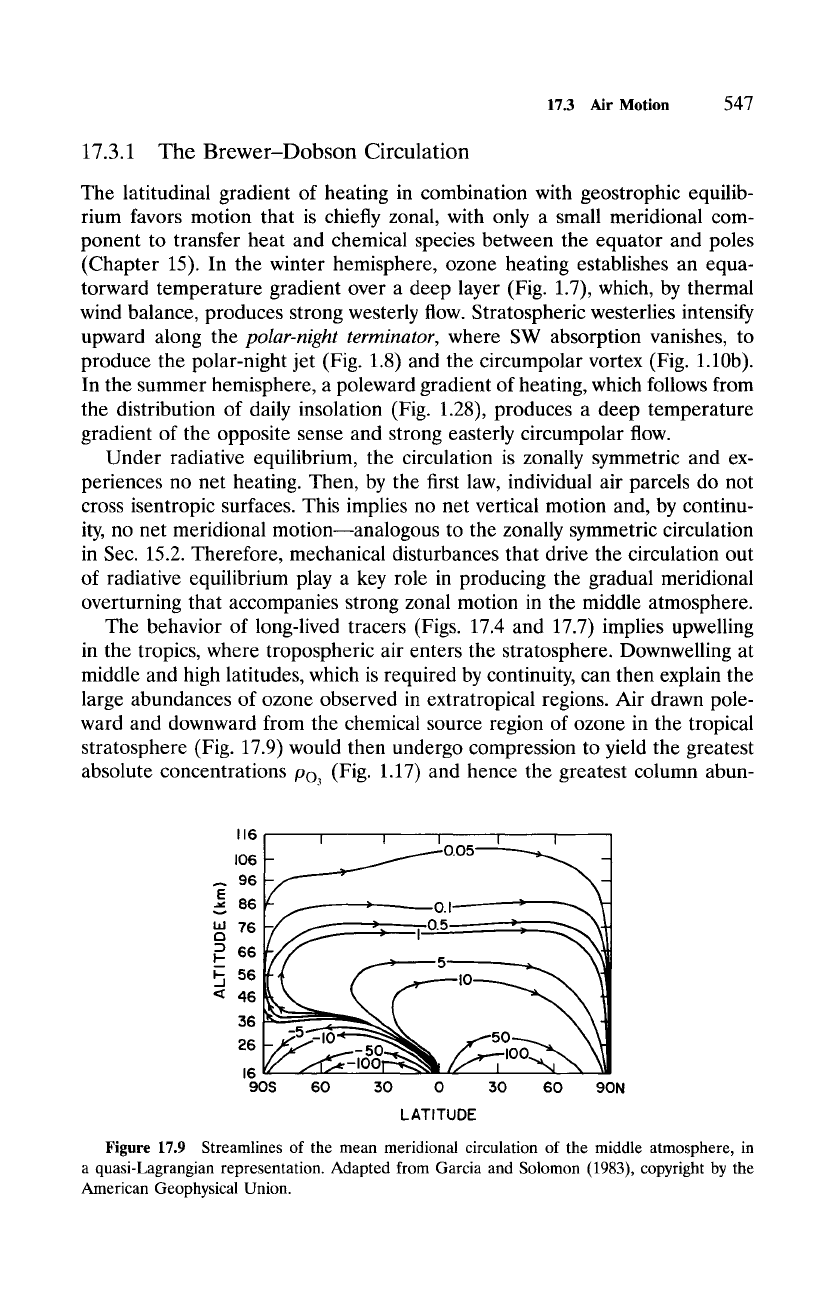
17.3 Air
Motion
547
17.3.1 The Brewer-Dobson Circulation
The latitudinal gradient of heating in combination with geostrophic equilib-
rium favors motion that is chiefly zonal, with only a small meridional com-
ponent to transfer heat and chemical species between the equator and poles
(Chapter 15). In the winter hemisphere, ozone heating establishes an equa-
torward temperature gradient over a deep layer (Fig. 1.7), which, by thermal
wind balance, produces strong westerly flow. Stratospheric westerlies intensify
upward along the
polar-night terminator,
where SW absorption vanishes, to
produce the polar-night jet (Fig. 1.8) and the circumpolar vortex (Fig. 1.10b).
In the summer hemisphere, a poleward gradient of heating, which follows from
the distribution of daily insolation (Fig. 1.28), produces a deep temperature
gradient of the opposite sense and strong easterly circumpolar flow.
Under radiative equilibrium, the circulation is zonally symmetric and ex-
periences no net heating. Then, by the first law, individual air parcels do not
cross isentropic surfaces. This implies no net vertical motion and, by continu-
ity, no net meridional motion--analogous to the zonally symmetric circulation
in Sec. 15.2. Therefore, mechanical disturbances that drive the circulation out
of radiative equilibrium play a key role in producing the gradual meridional
overturning that accompanies strong zonal motion in the middle atmosphere.
The behavior of long-lived tracers (Figs. 17.4 and 17.7) implies upwelling
in the tropics, where tropospheric air enters the stratosphere. Downwelling at
middle and high latitudes, which is required by continuity, can then explain the
large abundances of ozone observed in extratropical regions. Air drawn pole-
ward and downward from the chemical source region of ozone in the tropical
stratosphere (Fig. 17.9) would then undergo compression to yield the greatest
absolute concentrations
/903
(Fig. 1.17) and hence the greatest column abun-
E
LI.I
E3
I--
116 I
106
96
86
76
66
56
46
36
26
16
I ! I I I I
90S 60 50 0 50 60 90N
LATITUDE
Figure
17.9 Streamlines of the mean meridional circulation of the middle atmosphere, in
a quasi-Lagrangian representation. Adapted from Garcia and Solomon (1983), copyright by the
American Geophysical Union.
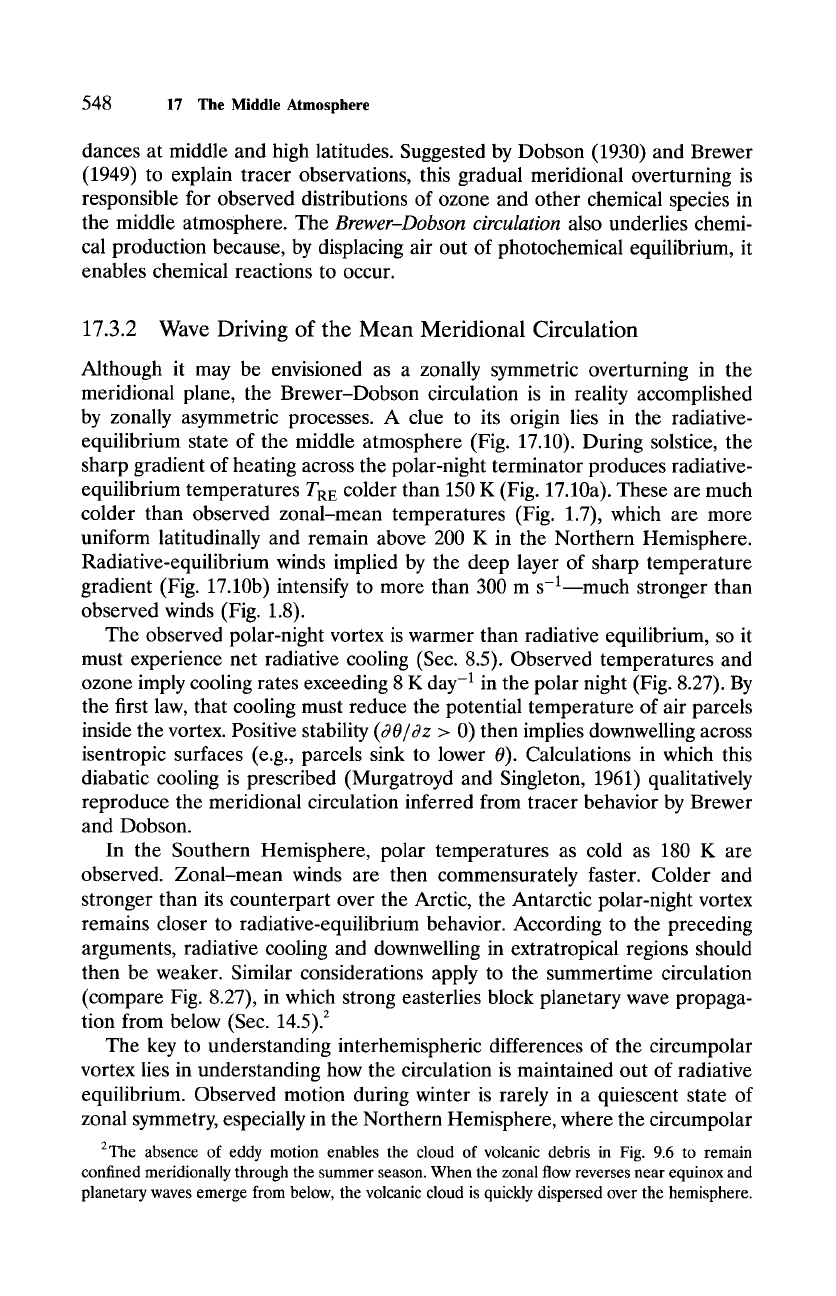
548
17 The Middle Atmosphere
dances at middle and high latitudes. Suggested by Dobson (1930) and Brewer
(1949) to explain tracer observations, this gradual meridional overturning is
responsible for observed distributions of ozone and other chemical species in
the middle atmoSphere. The Brewer-Dobson circulation also underlies chemi-
cal production because, by displacing air out of photochemical equilibrium, it
enables chemical reactions to occur.
17.3.2 Wave Driving of the Mean Meridional Circulation
Although it may be envisioned as a zonally symmetric overturning in the
meridional plane, the Brewer-Dobson circulation is in reality accomplished
by zonally asymmetric processes. A clue to its origin lies in the radiative-
equilibrium state of the middle atmosphere (Fig. 17.10). During solstice, the
sharp gradient of heating across the polar-night terminator produces radiative-
equilibrium temperatures TRE colder than 150 K (Fig. 17.10a). These are much
colder than observed zonal-mean temperatures (Fig. 1.7), which are more
uniform latitudinally and remain above 200 K in the Northern Hemisphere.
Radiative-equilibrium winds implied by the deep layer of sharp temperature
gradient (Fig. 17.10b) intensify to more than 300 m s-l--much stronger than
observed winds (Fig. 1.8).
The observed polar-night vortex is warmer than radiative equilibrium, so it
must experience net radiative cooling (Sec. 8.5). Observed temperatures and
ozone imply cooling rates exceeding 8 K day -1 in the polar night (Fig. 8.27). By
the first law, that cooling must reduce the potential temperature of air parcels
inside the vortex. Positive stability (30/3z > 0) then implies downwelling across
isentropic surfaces (e.g., parcels sink to lower 0). Calculations in which this
diabatic cooling is prescribed (Murgatroyd and Singleton, 1961) qualitatively
reproduce the meridional circulation inferred from tracer behavior by Brewer
and Dobson.
In the Southern Hemisphere, polar temperatures as cold as 180 K are
observed. Zonal-mean winds are then commensurately faster. Colder and
stronger than its counterpart over the Arctic, the Antarctic polar-night vortex
remains closer to radiative-equilibrium behavior. According to the preceding
arguments, radiative cooling and downwelling in extratropical regions should
then be weaker. Similar considerations apply to the summertime circulation
(compare Fig. 8.27), in which strong easterlies block planetary wave propaga-
tion from below (Sec. 14.5). 2
The key to understanding interhemispheric differences of the circumpolar
vortex lies in understanding how the circulation is maintained out of radiative
equilibrium. Observed motion during winter is rarely in a quiescent state of
zonal symmetry, especially in the Northern Hemisphere, where the circumpolar
2The absence of eddy motion enables the cloud of volcanic debris in Fig. 9.6 to remain
confined meridionally through the summer season. When the zonal flow reverses near equinox and
planetary waves emerge from below, the volcanic cloud is quickly dispersed over the hemisphere.
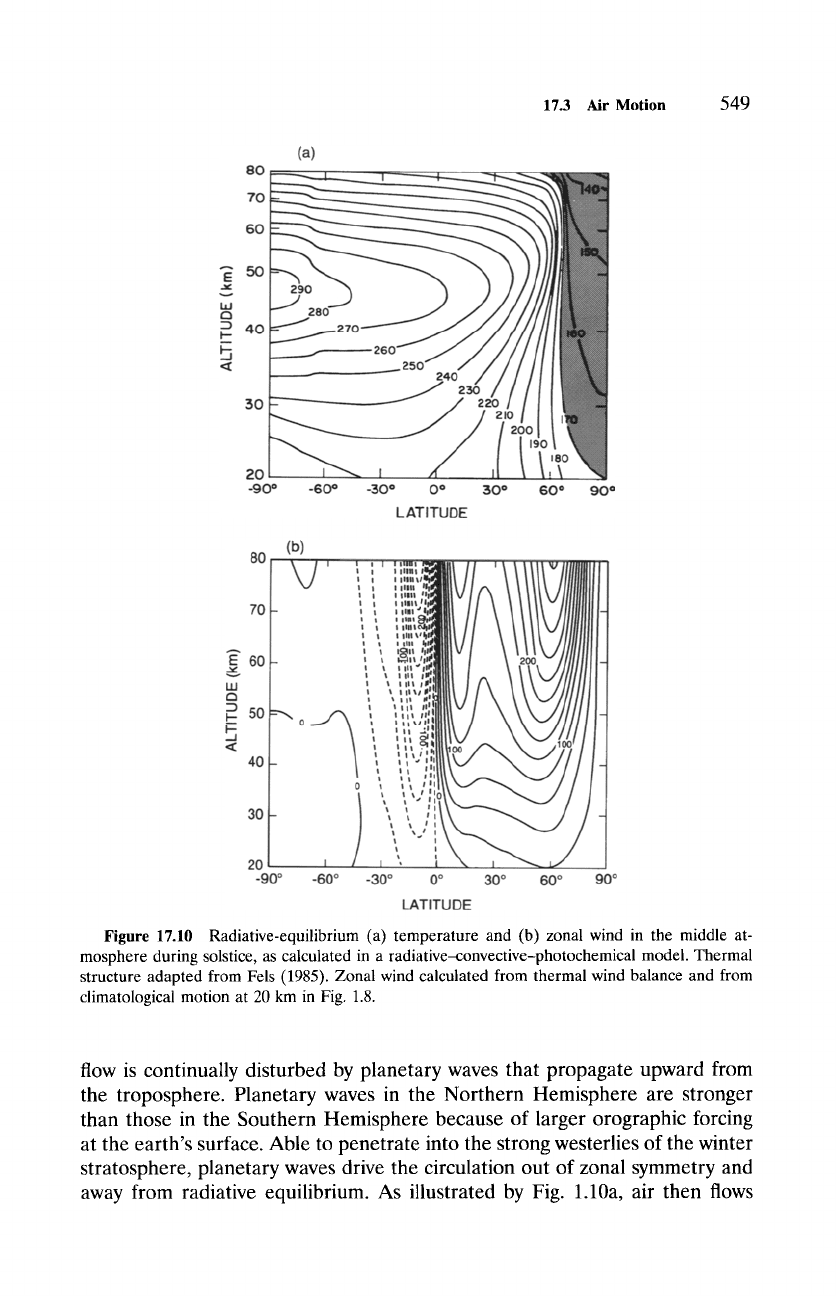
17.3 Air
Motion
549
80
70
60
5O
iaJ
r
40
I---
(a)
3O
20
-90 ~ -60 o -30 o 0 o 30 ~ 60 ~
LATITUDE
(b)
F
llll l//i
I I I IllU I!
', ', ',',',:~ A
'
t t t ii!11 ~
I I I IIII ~mll!
I I u II11 IiIg I
I I I~..11
~- ' , ~u'J'.elilNI
! % 200 V llll~
I 1 I III " i iP
g 80 /
,, ,, ,,,,,,,,/~ilillll
I A \ \\~'////
/
..... .~:.~lll%//\ \ \ k.;///~
I I I I I II I!
I I I I| II I|
40
', ',',
'' ''~
|
o',',',
/ t
,, ,, ,., !,,0\\ "---J /
20 I l "
90*
-90 ~ -60 o -30 o 0 o 30 ~ 60 ~ 90 ~
LATITUDE
Figure 17.10 Radiative-equilibrium (a) temperature and (b) zonal wind in the middle at-
mosphere during solstice, as calculated in a radiative-convective-photochemical model. Thermal
structure adapted from Fels (1985). Zonal wind calculated from thermal wind balance and from
climatological motion at 20 km in Fig. 1.8.
flow is continually disturbed by planetary waves that propagate upward from
the troposphere. Planetary waves in the Northern Hemisphere are stronger
than those in the Southern Hemisphere because of larger orographic forcing
at the earth's surface. Able to penetrate into the strong westerlies of the winter
stratosphere, planetary waves drive the circulation out of zonal symmetry and
away from radiative equilibrium. As illustrated by Fig. 1.10a, air then flows
